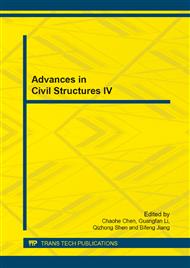p.1118
p.1125
p.1129
p.1134
p.1138
p.1145
p.1149
p.1153
p.1157
A Bridge Health Monitoring System Based on Wireless Smart Aggregates
Abstract:
Researches on health monitoring technology of concrete structures by using piezoelectric smart aggregates have achieved a great development. However, the technique is not widely used so far in practical engineering. Because when constructing large-scale structural health monitoring (SHM) system using wire-based sensors, it requires a lot of cables to form a monitoring network, resulting in huge cost of abundant material of wires and labor for wire placement, and the relatively heavy maintenance work in case of failure of the SHM system. A kind of wireless sensor network based on the protocol for Zigbee802.15.4 and the passive piezoelectric smart health monitoring technology is developed in the paper. Through internal load monitoring tests of a concrete bridge model under impact loading, the developed wireless smart aggregate (WSA) health monitoring system is experimentally validated. The finite element method (FEM) is used to simulate the process as the same as the bridge model test, and the numerical results are consistent with those of the experiment. The experimental results show that the developed wireless system is stable and reliable, and can be applied in concrete bridge structure health monitoring under impact loading.
Info:
Periodical:
Pages:
1138-1144
Citation:
Online since:
July 2014
Authors:
Price:
Сopyright:
© 2014 Trans Tech Publications Ltd. All Rights Reserved
Share:
Citation:


